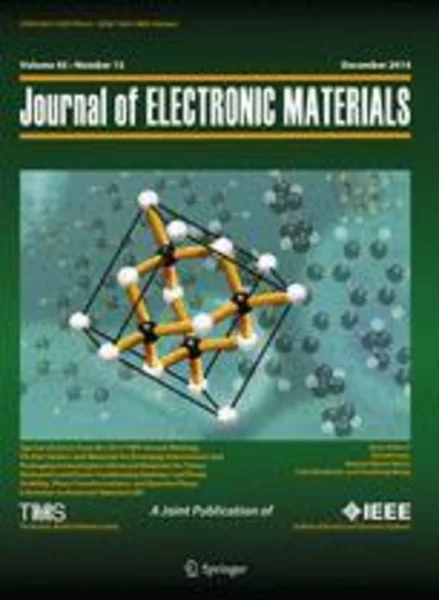-
selective cdte nanoheteroepitaxial growth on si(100) substrates using the close-spaced sublimation technique without the use of a mask
جزئیات بیشتر مقاله- تاریخ ارائه: 1392/07/24
- تاریخ انتشار در تی پی بین: 1392/07/24
- تعداد بازدید: 610
- تعداد پرسش و پاسخ ها: 0
- شماره تماس دبیرخانه رویداد: -
selective cdte nanoheteroepitaxial growth on si(100) substrates using the close-spaced sublimation technique without the use of a maskthe development of hgcdte detectors requires high sensitivity, small pixel size, low defect density, long-term thermal-cycling reliability, and large-area substrates. cdte bulk substrates were initially used for epitaxial growth of hgcdte films. however, cdte has a lattice mismatch with long-wavelength infrared (lwir) and middle-wavelength infrared (mwir) hgcdte that results in detrimental dislocation densities above mid-106 cm−2. this work explores the use of cdte/si as a possible substrate for hgcdte detectors. although there is a 19% lattice mismatch between cdte and si, the nanoheteroepitaxy (nhe) technique makes it possible to grow cdte on si substrates with fewer defects at the cdte/si interface. in this work, si(100) was patterned using photolithography and dry etching to create 500-nm to 1-μm pillars. cdte was selectively deposited on the pillar surfaces using the close-spaced sublimation (css) technique. scanning electron microscopy (sem) was used to characterize the cdte selective growth and grain morphology, and transmission electron microscopy (tem) was used to analyze the structure and quality of the grains. cdte selectivity was achieved for most of the substrate and source temperatures used in this study. the ability to selectively deposit cdte on patterned si(100) substrates without the use of a mask or seed layer has not been observed before using the css technique. the results from this study confirm that css has the potential to be an effective and low-cost technique for selective nanoheteroepitaxial growth of cdte films on si(100) substrates for infrared detector applications.
مقالات جدیدترین رویدادها
-
استفاده از تحلیل اهمیت-عملکرد در ارائه الگوی مدیریت خلاقیت سازمانی و ارائه راهکار جهت بهبود
-
بررسی تاثیر ارزش وجوه نقد مازاد بر ساختار سرمایه شرکت های پذیرفته شده در بورس اوراق بهادار تهران
-
بررسی تأثیر سطح افشای ریسک بر قرارداد بدهی شرکت های پذیرفته شده در بورس اوراق بهادار تهران
-
بررسی تأثیر رتبه بندی اعتباری مبتنی بر مدل امتیاز بازار نوظهور بر نقد شوندگی سهام با تأکید بر خصوصی سازی شرکت ها
-
تأثیر آمیخته بازاریابی پوشاک ایرانی بر تصویر ذهنی مشتری پوشاک ایرانی (هاکوپیان)
-
بازاریابی حسی: رویکرد نوین در صنعت بازاریابی
-
using jointly distributed random variables method to determination of saturated sand liquefaction reliability
-
ارائه مدل شبیه سازی برای بهینه سازی گردش مدارک کنترل پروژه
-
میوفیبروبلاستومای عقده لنفاوی در بازوی پسر بچه 13 ساله ”گزارش یک مورد“
-
برآورد بارمالی حوادث منجر به فوت در پروژه های ساختمانی شهر تهران در سال آتی
مقالات جدیدترین ژورنال ها
-
مدیریت و بررسی افسردگی دانش آموزان دختر مقطع متوسطه دوم در دروان کرونا در شهرستان دزفول
-
مدیریت و بررسی خرد سیاسی در اندیشه ی فردوسی در ادب ایران
-
واکاوی و مدیریت توصیفی قلمدان(جاکلیدی)ضریح در موزه آستان قدس رضوی
-
بررسی تاثیر خلاقیت، دانش و انگیزه کارکنان بر پیشنهادات نوآورانه کارکنان ( مورد مطالعه: هتل های 3 و 4 ستاره استان کرمان)
-
بررسی تاثیر کیفیت سیستم های اطلاعاتی بر تصمیم گیری موفق در شرکتهای تولیدی استان اصفهان (مورد مطالعه: مدیران شرکتهای تولیدی استان اصفهان)
-
تحلیل حکم حکومتی در فقه سیاسی
-
پنهان کاری در انتقال داده های پزشکی ایمن برای سیستم های مراقبت بهداشتی مبتنی بر iot
-
ارتباط کوته بینی مدیران با نوسانات سود و سهامداران عمده در شرکت های پذیرفته شده در بورس اوراق بهادار تهران
-
ارائه الگوی مدیریت استعداد در نهاجا
-
utilization of palm oil fuel ash and eggshell powder as partial cement replacement - a review




سوال خود را در مورد این مقاله مطرح نمایید :